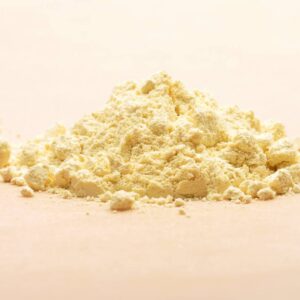Research Focus and Objectives
Investigates the use of lupin flour as a substitute for wheat flour in both conventional and sourdough bread formulations.
Aims to assess the technological (dough and bread quality) and nutritional impacts of incorporating lupin flour, with and without sourdough fermentation.
Methodology
Experimental breadmaking trials were conducted with varying levels of lupin flour substitution.
Both conventional (yeast-leavened) and sourdough fermentation processes were tested.
Key parameters measured included dough stability, fermentation kinetics, crumb structure, bread hardness, and nutritional composition.
Key Findings
Dough Properties:
Addition of lupin flour (with or without sourdough) decreased dough stability, delayed fermentation, and resulted in lower pH values.
These changes were more pronounced in sourdough systems.
Bread Texture and Structure:
Incorporating lupin flour increased crumb hardness in conventional bread.
However, using sourdough (at 15 g/100 g) with lupin flour mitigated the increase in hardness, producing a softer crumb than conventional lupin bread5.
Both lupin flour and sourdough affected bread volume and structure, generally reducing loaf volume and altering crumb porosity.
Nutritional Impact:
Lupin flour is high in protein and dietary fibre, so its inclusion improved the nutritional profile of the breads.
The protein content of the final bread increased with higher lupin flour substitution.
Sourdough fermentation further enhanced the nutritional quality by improving protein digestibility and reducing anti-nutritional factors.
Sensory Aspects:
The study notes changes in bread flavour and aroma with lupin flour and sourdough use, but detailed sensory results are not specified in the summary.
Implications
Technological:
Lupin flour can be used as a partial wheat substitute in breadmaking, but adjustments in processing (such as using sourdough) are needed to optimize bread texture and quality.
Sourdough fermentation is particularly beneficial for counteracting the negative effects of lupin on bread hardness and structure.
Nutritional:
Breads with lupin flour offer higher protein and fibre content, making them attractive for consumers seeking functional or high-protein foods.
Sourdough processing further improves the nutritional value, supporting its use in health-oriented bakery products.
Conclusions
Lupin flour is a promising wheat alternative for both conventional and sourdough bread, provided that formulation and process parameters are optimized.
Sourdough fermentation is a key technological tool to improve the quality and nutritional value of lupin-containing breads.
Summary
Objective: Evaluate lupin flour as a wheat substitute in conventional and sourdough bread for technological and nutritional properties.
Method: Experimental breadmaking with various lupin flour levels; tested both yeast and sourdough fermentation5.
Dough Effects:
Lupin flour reduces dough stability and slows fermentation.
Sourdough intensifies these effects but lowers pH.
Bread Quality:
Lupin increases crumb hardness in conventional bread.
Sourdough with lupin (15 g/100 g) results in softer bread than conventional lupin bread5.
Both reduce loaf volume and alter crumb structure.
Nutritional Impact:
Lupin flour raises protein and fibre content.
Sourdough improves protein digestibility and reduces anti-nutrients5.
Sensory Changes: Bread flavour and aroma altered by lupin and sourdough (details not specified).
Implications:
Lupin flour is viable for healthier, high-protein bread.
Sourdough is essential for optimal texture and nutrition in lupin breads.
Conclusion: Lupin flour, especially with sourdough, can enhance bread’s nutritional value while maintaining acceptable quality if processing is carefully managed.






